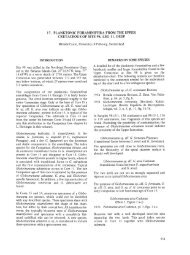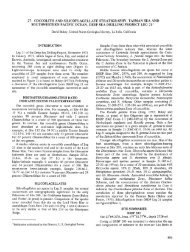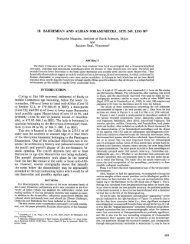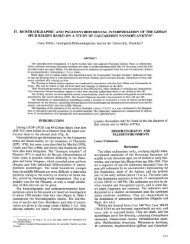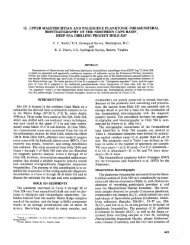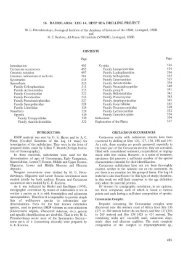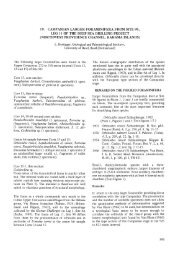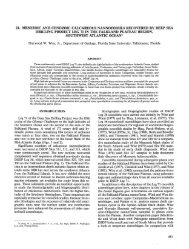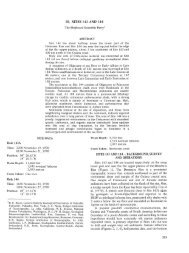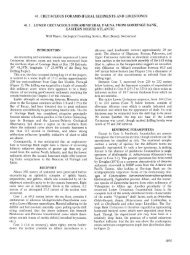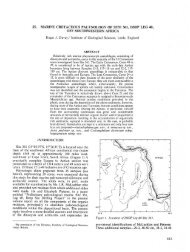1 - Deep Sea Drilling Project
1 - Deep Sea Drilling Project
1 - Deep Sea Drilling Project
Create successful ePaper yourself
Turn your PDF publications into a flip-book with our unique Google optimized e-Paper software.
of D. epiodon (Plate 2, Figure 8), with which it has only general<br />
similarity. D. fibula specimens having smooth basal rings are the overwhelmingly<br />
predominant form in Panama Basin cores, indicating that<br />
possession of distal pikes on the basal ring is not a warm-water character.<br />
Geographically, Dictyocha fibula is cosmopolitan, occurring in<br />
oceanic areas at high and low latitudes. Ling (1970) demonstrated that,<br />
whereas D. fibula is present in core samples from high latitude in the<br />
Pacific, it is numerically dominated by Distephanus speculum. In our<br />
low-latitude, warm-water assemblages, D. fibula is the preeminent<br />
species. Though cosmopolitan, D. fibula is most successful in<br />
warm-water areas. A laboratory-culture study of D. fibula specimens<br />
collected near Edmonds, Washington, indicated optimum<br />
growth at 10°C and 24 per cent salinity (Van Valkenburg and<br />
Norris, 1970). As it is unlikely that the temperature of near-surface<br />
water inhabited by abundant D. fibula populations in the Panama<br />
Basin ever fell to 10°C, a latitudinal series of races of D. fibula, each<br />
suited to the ambient temperature of the region, probably exists. A<br />
repeat of the Van Valkenburg-Norris experiment on cultures of<br />
tropical and arctic D. fibula might demonstrate this supposition and<br />
show skeletal variation useful in paleoenvironmental interpretation.<br />
Would a clonal culture of tropical D. fibula produce the group of<br />
aberrant skeletons illustrated by Van Valkenburg and Norris? They<br />
show forms reminiscent of fossil Dictyocha pentagona and D.<br />
pseudofibula, which were noted only sporadically in samples from<br />
the Panama Basin. Do the fossil Panama Basin occurrences therefore<br />
indicate colder waters and lower salinities? Or, are other ecologic<br />
factors such as grazing or nitrogen supply chiefly responsible<br />
(McGowan, 1971;Tapρan, 1971)?<br />
Stratigraphically, Dictyocha fibula ranges throughout the Miocene to<br />
Pleistocene sections examined. Bachmann's (1970) upper Oligocene assemblage<br />
from Austria lacks D. fibula. A reversal in dominance between<br />
D. fibula and D. aspera in the upper Miocene (Martini, 1971) provides<br />
a general indication of the stratigraphic position of samples within the<br />
Distephanus crux Zone.<br />
Dictyocha japonica Deflandre, 1950<br />
(Plate 3, Figure 3)<br />
Remarks: A single small specimen of this cool-water species was<br />
observed in the upper Miocene at DSDP 157.<br />
Dictyocha medusa Haeckle, 1887<br />
(Plate 3, Figures 4-5)<br />
Remarks: This simple species is characterized by the absence of an<br />
apical bar or apical ring. Four struts meet at a central point, forming an<br />
x. This species is distinguished from forms of Dictyocha aspera that have<br />
a vestigial apical bar by the direct alignment of opposing struts across<br />
the center point. Mandra (1968) pointed out the Miocene age of this<br />
species under the name Dictyocha staurodon. The present study of sections<br />
at DSDP 157, DSDP 157A, DSDP 158, and the Experimental<br />
Mohole confirms the restriction of D. medusa to the Miocene.<br />
Dictyocha navicula Ehrenberg, 1839<br />
(Plate 3, Figures 6-8)<br />
Remarks: The form of the body ring is basically elliptical with varying<br />
degrees of elongation. The most typical forms in Panama Basin cores<br />
are those showing little elongation (Plate 3, Figure 8). Dictyocha navicula<br />
is generally rare and sporadic, being common only in sample DSDP<br />
158-1 l-(CC).<br />
Dictyocha octagona (Tsumura) n. comb.<br />
(Plate 3, Figure 9)<br />
Dictyocha fibula var. octagona Tsumura, 1963, p. 55, 56, 71, pi. 2, fig.<br />
4; pi. 10, figs. 11-13; pi. 23, figs. 8-10.<br />
Dictyocha octagona Tsumura, of Martini, 1971, p. 1697, pi. 1, fig. 15.<br />
Remarks: The basal ring of this species is symmetrically octagonal<br />
with distal spines at the apices. One pair of opposing spines is distinctly<br />
longer than the others. The apical bar is aligned nearly perpendicularly<br />
with this pair of spines.<br />
Dictyocha octagona occurs only at the bottom of the Experimental<br />
Mohole section and is absent in the stratigraphically higher sections at<br />
DSDP 157 and DSDP 158. As it does not consistently range as high as<br />
Corbisema triacantha in warm-water Pacific sections, it may be a useful<br />
guide to the Distephanus octacanthus Zone.<br />
SILICOFLAGELLATE AND DIATOM STRATIGRAPHY<br />
Dictyocha pentagona (Schulz) n. comb.<br />
(Plate 3, Figure 10)<br />
Dictyocha fibula var. pentagona Schulz, 1928, p. 255, figs. 41a, b—Loeblich<br />
et al., 1968, p. 96, pi. 12, figs. 13, 14.<br />
Remarks: The basal ring of this species is pentagonal and asymmetric,<br />
with five equant spines at the apices. The apical bar may be straight<br />
or crooked and is connected to the basal ring by five struts of unequal<br />
length. This species is rare in the cores examined, but occurrences are<br />
noted in the upper Pleistocene, Pliocene, and middle Miocene.<br />
Dictyocha pseudofibula (Schulz) Tsumura, 1963<br />
(Plate 3, Figures 2 and 11)<br />
Remarks: This form is rare and sporadic in our cores and may be an<br />
environmentally induced variant of Dictyocha fibula (see Van Valkenburg<br />
and Norris, 1970). It is more common in cool-water assemblages<br />
at higher latitudes.<br />
Dictyocha vanandelii Bukry and Foster, n. sp.<br />
(Plate 7, Figure 1)<br />
Description: This large species is bilaterally symmetric. The body<br />
ring is in the form of a modified ellipse with one end flattened. Three<br />
struts meet at the center point of the ellipse dividing the intra-ring area<br />
into three portals. Five distal pikes on the body ring are situated at the<br />
three apices and at the points where the two long struts meet the body<br />
ring.<br />
Remarks: This unusual form is reminiscent of Corbisema owing to<br />
the tripartite division of the central area by struts. However, Dictyocha<br />
vanandelii is distinguished by having five basal-ring pikes and a modified<br />
elliptic outline. Dictyocha Jπ/y>/α Ehrenberg has a three-part strut system<br />
but has four pikes and no flattening of the body ring. This species is<br />
named in recognition of the leadership of Dr. Tj. H. van Andel in marine<br />
geologic studies of the Panama Basin.<br />
Occurrence: Dictyocha vanandelii is presently known only from<br />
DSDP 157-22(CC), which is lower upper Pliocene.<br />
Size: Length and width about 75 microns.<br />
Holotype: USNM 182796 (Plate 7, Figure 1).<br />
Type locality: DSDP 157-22(CC), approximate subbottom depth<br />
207 meters, Carnegie Ridge, Panama Basin.<br />
Genus DISTEPHANUS Stöhr, 1880<br />
Distephanus boliviensis (Frenguelli) n. comb.<br />
(Plate 4, Figures 1-3)<br />
Dictyocha boliviensis Frenguelli, 1940, p. 44, fig. 4._Loeblich et<br />
al., 1968, p. 83, pi. 9, fig. 3<br />
Remarks: This especially large species is characterized by equant<br />
distal spines on six- or seven-sided basal rings, by an open apical ring,<br />
and usually by six of seven proximal pikes on the basal ring. Characteristic<br />
forms are most prominent in upper Pliocene samples from DSDP<br />
157, although smaller forms with less equant spines (resembling<br />
Distephanus speculum) occur in the lower Pliocene and upper upper<br />
Miocene (Plate 4, Figure 4).<br />
Distephanus crux (Ehrenberg) Haeckle, 1887<br />
(Plate 4, Figures 5-6)<br />
Remarks: This species has four-part symmetry. The apical opening<br />
is typically small. Although Distephanus crux is long-ranging, it is relatively<br />
meager in the Panama Basin sections. Its greatest abundance, as<br />
much as 90 per cent of some assemblages, has been noted in middle<br />
Miocene samples from Maryland and California. Ling (1970) and<br />
the present study suggest that Distephanus crux dwindled into<br />
obscurity after the end of the Miocene, becoming rare in later<br />
epochs. Its great abundance in mid-latitude samples contrasts with<br />
its meager to common occurrence in coeval middle Miocene samples<br />
from the Panama Basin, suggesting that its optimum growth<br />
environment was temperate instead of tropical.<br />
A specimen of Distephanus crux with a basal ring like that of associated<br />
Dictyocha epiodon is illustrated (Plate 4, Figure 5). The occasional<br />
convergence of basal-ring structures, such as this, between coeval<br />
species of Distephanus and Dictyocha suggests close biologic affinities<br />
between certain members of these genera. Compare coeval Dictyocha<br />
octagona and Distephanus octacanthus illustrated here (Plate 3, Figure<br />
9; Plate 4, Figure 12) and Gemeinhardfs (1930) illustrations of Dictyocha<br />
pseudofibula and Dictyocha pseudocrux.<br />
827



